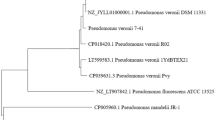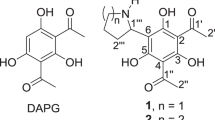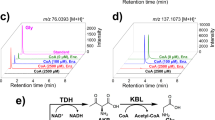Abstract
Pseudomonas diminuta strain MG hydrolyzes parathion to diethylthiophosphoric acid and p-nitrophenol. The esterase responsible for this reaction is encoded by a gene located on a plasmid termed pCMS1. The gene was cloned into plasmid pBR322 and the broad host range cloning vector pKT230. Enzyme activity was detected in Escherichia coli strains that contained the recombinant plasmids. A 1.5 kilobase BamHI fragment with single restriction sites for SalI, PstI and XhoI was shown to direct the synthesis of the enzyme. The 1.5 kilobase BamHI fragment was inserted into the high expression vector pUC7, and the resulting recombinant, pCMS40, was used to construct pKT230 derivatives containing the parathion hydrolase gene. Subsequent transfer of the recombinant plasmids into a cured derivative of P. diminuta MG and a p-nitrophenol-utilizing strain of Pseudomonas resulted in the isolation of transconjugants that exhibited parathion hydrolase activity. The highest enzyme activity was observed with P. diminuta MG.
This is a preview of subscription content, access via your institution
Access options
Subscribe to this journal
Receive 12 print issues and online access
$209.00 per year
only $17.42 per issue
Buy this article
- Purchase on Springer Link
- Instant access to full article PDF
Prices may be subject to local taxes which are calculated during checkout
Similar content being viewed by others
References
Munnecke, D.M. 1981. The use of microbial enzymes for pesticide detoxification, p. 251–270. In: Microbial degradation of xenobiotics and recalcitrant compounds. Leisinger, T., Cook, A.M., Hütter, R., and Nüesch, J. (eds.), Academic Press Inc., London.
Dagley, S. 1984. Introduction, p. 1–11. In: Microbial degradation of organic compounds. Gibson, D.T. (ed.), Marcel Dekker Inc., New York.
Munnecke, D.M. and Hsieh, D.P.H. 1976. Pathways of microbial metabolism of parathion. Appl. Environ. Microbiol. 31: 63–69.
Serdar, C.M., Gibson, D.T., Munnecke, D.M. and Lancaster, J.H. 1982. Plasmid involvement in parathion hydrolysis by Pseudomonas diminuta. Appl. Environ. Microbiol. 44: 246–249.
Munnecke, D.M. 1976. Enzymatic hydrolysis of organophosphate insecticides, a possible pesticide disposal method. Appl. Environ. Microbiol. 32: 7–13.
Munnecke, D.M. Enzymatic detoxification of waste organophosphate pesticides. J. Agric. Food Chem. 28: 105–111.
Simpson, J.R. and Evans, W.C. 1953. The metabolism of nitrophenols by certain bacteria. Biochem. J. 55: xxiv.
Spain, J.C., Wyss, O. and Gibson, D.T. 1979. Enzymatic oxidation of p-nitrophenol. Biochem. Biophys. Res. Commun. 88: 634–641.
Cook, A.M., Daughton, C.G. and Alexander, M. 1978. Phosphorus-containing pesticide breakdown products: Quantitative utilization as phosphorus sources by bacteria. Appl. Environ. Microbiol. 36: 668–672.
Haas, D. 1983. Genetic aspects of biodegradation by pseudomonads. Experientia 39: 1199–1213.
Boyer, H.W. and Roulland-Dussoix, D. 1969. A complementation analysis of the restriction and modification of DNA in Escherichia coli. J. Mol. Biol. 41: 459–472.
Hohn, B. 1979. In vitro packaging of λ and cosmid DNA. Meth. Enzymol. 68: 299–309.
Amann, E., Brosius, J. and Ptashne, M. 1983. Vectors bearing a hybrid trp-lac promoter useful for regulated expression of cloned Genes in Escherichia coli. Gene 25: 167–178.
Bolivar, F., Rodriguez, R.L., Greene, P.J., Betlach, M.C., Heyneker, H.L., Boyer, H.W., Crosa, J.H. and Falkow, S. 1977. Construction and characterization of new cloning vehicles II. A multipurpose cloning system. Gene 2: 95–113.
Bagdasarian, M., Lurz, R., Rückert, B., Franklin, F.C.H., Bagdasarian, M.M., Frey, J. and Timmis, K.N. 1981. Specific-purpose plasmid cloning vectors II. Broad host range, high copy number, RSF1010-derived vectors, and a host-vector system for Gene cloning in Pseudomonas. Gene 16: 237–247.
Vieira, J. and Messing, J. 1982. The pUC plasmids, an M13mp7-derived system for insertion mutagenesis and sequencing with synthetic universal primers. Gene 19: 259–268.
Figurski, D.H. and Helinski, D.R. 1979. Replication of an origin-containing derivative of plasmid RK2 dependent on a plasmid function provided in trans. Proc. Natl. Acad. Sci. USA. 76: 1648–1652.
Bachmann, B.J. 1983. Linkage map of Escherichia coli K-12, edition 7. Microbiol. Rev. 47: 180–230.
Stüber, D. and Bujard, H. 1981. Organization of transcriptional signals in plasmids pBR322 and pACYC184. Proc. Natl. Acad. Sci. USA. 78: 167–171.
Inouye, S., Ebina, Y., Nakazawa, A. and Nakazawa, T. 1984. Nucleotide sequence surrounding transcription initiation site of xylABC operon on TOL plasmid of Pseudomonas putida. Proc. Natl. Acad. Sci. USA. 18: 1688–1691.
Inouye, S., Nakazawa, A. and Nakazawa, T. 1984. Nucleotide sequence of the promoter region of the xylDEGF operon on TOL plasmid of Pseudomonas putida. Gene 29: 323–330.
West, R.W. and Rodriguez, R.L. 1982. Construction and characterization of E. coli promoter-probe plasmid vectors III. pBR322 derivatives with deletions in the tetracycline resistance promoter region. Gene 20: 291–304.
Zech, R. and Wigand, K.D. 1975. Organophosphate-detoxicating enzymes in E. coli. Gelfiltration and isoelectric focusing of DFPase, paraoxonase and unspecific phosphohydrolases. Experientia 31: 157–158.
Stanier, R.Y., Palleroni, N.J. and Doudoroff, M. 1966. The aerobic pseudomonads: a taxonomic study. J. Gen. Microbiol. 43: 149–271.
Kado, C.I. and Liu, S.-T. 1981. Rapid procedure for detection and isolation of large and small plasmids. J. Bacteriol. 145: 1365–1373.
Hansen, J.B. and Olsen, R.H. 1978. Isolation of large bacterial plasmids and characterization of the P2 incompatibility group plasmids pMG1 and pMG5. J. Bacteriol. 135: 227–238.
Holmes, D.S. and Quigley, M. 1981. A rapid boiling method for the preparation of bacterial plasmids. Anal. Biochem. 114: 193–197.
Humpreys, G.O., Willshaw, G.A. and Anderson, E.S. 1975. A simple method for the preparation of large quantities of pure plasmid DNA. Biochim. Biophys. Acta. 383: 457–463.
Meyers, J.A., Sanchez, D., Elwell, L.P. and Falkow, S. 1976. Simple agarose gel electrophoretic method for the identification and characterization of plasmid deoxyribonucleic acid. J. Bacteriol. 127: 1529–1537.
Cohen, S.N., Chang, A.C.Y. and Hsu, L. 1972. Nonchromosomal antibiotic resistance in bacteria: genetic transformation of Escherichia coli by R-factor DNA. Proc. Natl. Acad. Sci. USA. 69: 2110–2114.
Ditta, G., Stanfield, S., Corbin, D. and Helinski, D.R. 1980. Broad host range DNA cloning system for gram-negative bacteria: Construction of a Gene bank of Rhizobium meliloti. Proc. Natl. Acad. Sci. USA 77: 7347–7351.
Bradford, M.M. 1976. A rapid and sensitive method for the quantitation of microgram quantities of protein utilizing the principle of protein-dye binding. Anal. Biochem. 72: 248–254.
Author information
Authors and Affiliations
Rights and permissions
About this article
Cite this article
Serdar, C., Gibson, D. Enzymatic Hydrolysis of Organophosphates: Cloning and Expression of a Parathion Hydrolase Gene from Pseudomonas diminuta. Nat Biotechnol 3, 567–571 (1985). https://doi.org/10.1038/nbt0685-567
Received:
Accepted:
Issue Date:
DOI: https://doi.org/10.1038/nbt0685-567
This article is cited by
-
Insight into the environmental fate, hazard, detection, and sustainable degradation technologies of chlorpyrifos—an organophosphorus pesticide
Environmental Science and Pollution Research (2023)
-
Simultaneous degradation of organophosphate and organochlorine pesticides by Sphingobium japonicum UT26 with surface-displayed organophosphorus hydrolase
Biodegradation (2013)
-
Purification and characterization of methyl parathion hydrolase from Burkholderia cepacia capable of degrading organophosphate insecticides
World Journal of Microbiology and Biotechnology (2012)
-
An isofenphos-methyl hydrolase (Imh) capable of hydrolyzing the P–O–Z moiety of organophosphorus pesticides containing an aryl or heterocyclic group
Applied Microbiology and Biotechnology (2012)
-
Intra- and extra-cellular organophosphorus hydrolase production with recombinant E. coli using fed-batch fermentation
World Journal of Microbiology and Biotechnology (2008)



